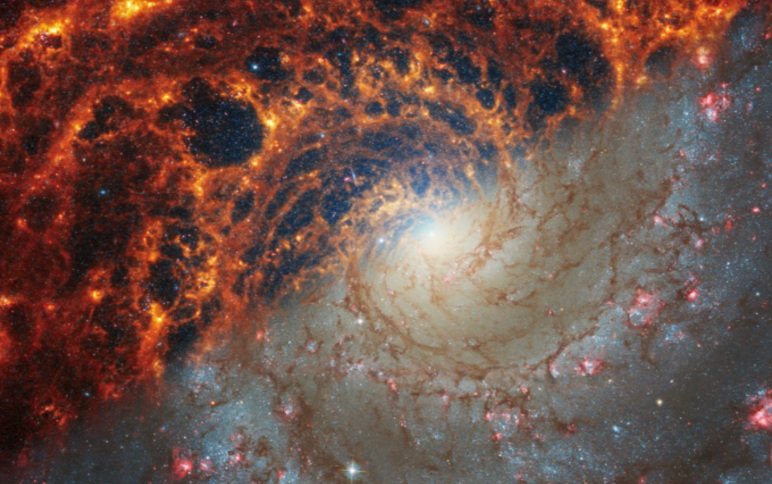
“The evolution of the world can be compared to a display of fireworks that has just ended: some few red wisps, ashes and smoke. Standing on a well-chilled cinder, we see the slow fading of the suns, and we try to recall the vanished brilliance of the origin of worlds.”
― Georges Lemaître
Our Research
During the Universe’s metaphorical childhood, there exists a population of galaxies that are so extreme in their nature that many of our most sophisticated cosmological simulations struggle to produce them. These are the most massive galaxies of their time, and they likely birthed some of the first stars ever to form in our cosmos. Our work is centered on understanding what conditions create these behemoths, and what conditions prevent them from growing any further throughout the remainder of cosmic time.
We use observations, numerical modeling, and simulations to tease out the mechanisms that drive rapid galaxy evolution in the early cosmos. We specialize in near-to-far infrared light typically measured using JWST and ALMA, which enables us to follow the different baryonic components of these galaxies (i.e. stars, gas, and dust) as they evolve through time. It is in this red light that we believe we can unlock clues to these mysteries, and discover the origins of the Universe we see today.
-

Star Formation at the Extremes
In order to make massive galaxies in the early Universe, the conditions must be just right. The most efficient star formers we’ve discovered so far are heavily dust-obscured, infrared luminous galaxies. We study these galaxies in detail to understand what unique properties catalyze such rapid and efficient star formation.
-

Dust & Gas in Massive Galaxies
Cold gas is fuel for star formation, and dust produced by stars is an important gas coolant. Studying these two components can teach us about the galaxy’s history of star formation, and it’s future potential. However, many unknowns remain on how these components are introduced into a galaxy, and what happens to them over time. This is where our work comes in.
-

Clustering in the Early Cosmos
Some galaxies reside in crowded regions of our cosmos, where the likelihood of galaxies merging together is high. Galaxy mergers can trigger extreme star formation and black hole growth — both of which may drastically alter the galaxy’s future. We investigate whether massive early galaxies are preferentially clustered, and what that could mean for their formation and evolution.
Select Publications
See the most up to date list here.
Cooper, O., et al. incl. Long, (2025). RUBIES: JWST/NIRSpec resolves evolutionary phases of dusty star-forming galaxies at z ∼ 2. ApJ, 982, 125
McKinney, Casey, Long, et al. (2025). SCUBADive. I. JWST+ALMA Analysis of 289 Submillimeter Galaxies in COSMOS-Web. ApJ, 979, 229
de la Vega, A., et al. incl. Long, (2025). Searching for Quiescent Galaxies over 3 < z < 6 in JWST Surveys Using Manifold Learning. ArXiv e-print 2501.09066
Lorenzon, G., et al. incl. Long, (2025). Tracing the evolutionary pathways of dust and cold gas in high-z quiescent galaxies with SIMBA. A&A, 693, 118
Nere, R. and Long, Arianna S., (2024). Mock JWST Colors of Two Different Star Formation Histories at z 4. RNAAS, 8, 303
Casey, C., et al. incl. Long, (2024). Dust in Little Red Dots. ApJ, 975, 4
Long et al., (2024). The Extended Mapping Obscuration to Reionization with ALMA (Ex-MORA) Survey : 5σ Source Catalog and Redshift Distribution. ArXiv e-print 2408.14546
Long et al., (2024). Efficient NIRCam Selection of Quiescent Galaxies at 3 < z < 6 in CEERS. ApJ, 970, 68
Akins, H., et al. incl. Long, (2024). COSMOS-Web : The over-abundance and physical nature of “little red dots”– Implications for early galaxy and SMBH assembly. ArXiv e-print 2406.10341
McKinney, J., et al. incl. Long, (2023). A Near-infrared-faint, Far-infrared-luminous Dusty Galaxy at z∼5 in COSMOS-Web. ApJ, 956, 72
Casey, C. M., et al. incl. Long, (2023). COSMOS-Web : An Overview of the JWST Cosmic Origins Survey. ApJ, 954, 31
Long, Arianna S., et al., (2023). Missing Giants: Predictions on Dust-Obscured Galaxy Stellar Mass Assembly Throughout Cosmic Time. ApJ, 953, 11
Zavala, J. A., et al. incl. Long, (2023). Dusty Starbursts Masquerading as Ultra-high Redshift Galaxies in JWST CEERS Observations. ApJL, 943, 9
Casey, C. M., et al. incl. Long, (2021). Mapping Obscuration to Reionization with ALMA (MORA): 2 mm Efficiently Selects the Highest-Redshift Obscured Galaxies. ApJ, 923, 215
Chan, A., Long, Arianna S., and Cooray, A. (2021), Characteristics of an Extreme Dusty Star-forming Galaxy at z = 4.5, RNAAS, 5, 5
Champagne, J., et al. incl. Long, (2021). Comprehensive Gas Characterization of a z = 2.5 Protocluster : A Cluster Core Caught in the Beginning of Virialization , ApJ, 913, 110
Zavala, J, et al. incl. Long, Arianna S. 2021, The Evolution of the IR Luminosity Function and Dust-obscured Star Formation in the Past 13 Billion Years. ApJ, 909, 165
Long, Arianna S., et al. 2020, Emergence of an Ultra-Red, Ultra-Massive Galaxy Cluster Core at z = 4. ApJ, 898, 133L
Ma, J., Cooray, A., Nayyeri, H., Brown, Arianna S., et al. 2019, Spitzer Catalog of Herschel-Selected Ultrared Dusty, Star-Forming Galaxies. ApJS, 244, 30
Brown, Arianna S., et al. 2019, Infrared Contributions of X-Ray Selected Active Galactic Nuclei in Dusty Star-Forming Galaxies. ApJ, 871, 87